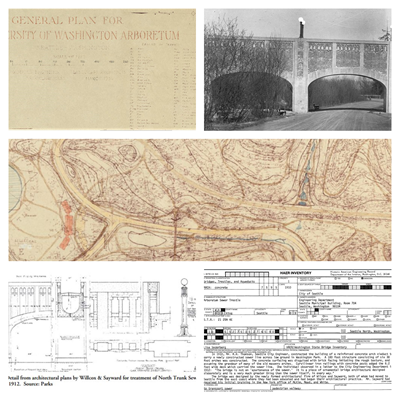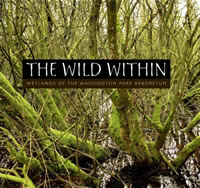I am researching the early years of the Washington Park Arboretum for a historical narrative I’m writing. Can you tell me what is growing near the footbridge from E. Lynn Street into the Arboretum in a January 1912 photograph? Do you know when the bridge was constructed?
I did find a 1935 plan from the Olmsted archives which seems to have a full inventory of plants, but some of the abbreviations escape me.
I am seeking any other online sources that might help in my research.
The bridge, designed by the architects William Sayward and Walter Willcox, was built in 1910, and at the time was referred to as the Arboretum Sewer Trestle or the Arboretum Aqueduct. Because the photo was taken in winter, it does not provide useful clues about the bare shrubs and trees. However, the 1935 plan does yield information, assuming some of those plants would have been there at the time of your photo. I can decode some of the abbreviations (such as Syc for sycamore, V.M. for vine maple, and Cot for cottonwood, W for willow, and A could be alder), and an awful lot of “Cat,” which turns out to be Catalpa, according to the 1936 plan’s Legend of Trees in the high resolution version of the image.
In addition to the Olmsted archives online, you may find these links useful:
- Washington Park Arboretum Historic Review
- Seattle Municipal Archives Digital Collections, searchable by keyword
- Museum of History and Industry (search digital collections)
- UW Libraries Digital Collections
- About the Arboretum Sewer Trestle
- Paul Dorpat’s Then and Now, on the Willcox Bridge
- National Register of Historic Places application: Lake Washington Boulevard history—see section 2 on the Arboretum and the footbridge: excerpt:
“A significant feature of the Washington Park Arboretum that passes directly over Lake Washington Blvd. near the arboretum’s northern extent is the Arboretum Aqueduct and Sewer Trestle (also known as the Willcox Footbridge) (Contributing Resource No. 2; 1910). The bridge is a multiarched, concrete-and-brick pedestrian bridge that filters foot traffic over Lake Washington Blvd. The City built the structure in 1910 to carry a newly constructed sewer line over low ground. The aqueduct is a Seattle City Landmark and was listed in the NRHP in 1982.”

